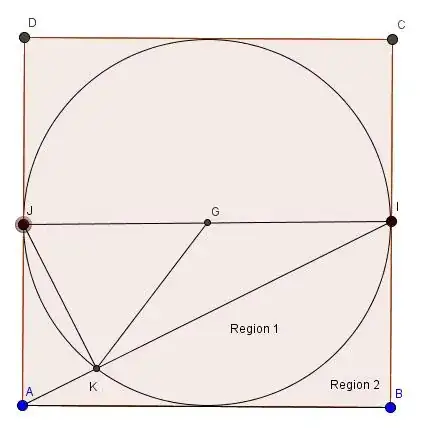
My Attempt,
Area of square $=10^2=100 cm^2$.
Area of circle $=\pi r^2=25\pi cm^2$.
What should I do further?
First label the points and regions as shown

$G$ is the center of the circle, $I,J$ are mid points of $AD, BC$.
First observe that $KJ\perp AI$ by Thale's theorem. Also we know that $IJ\perp AD$ as $I$ and $J$ are mid points of the two parallel sides. Thus it's not hard to show that $\Delta AIJ$ is similar to $\Delta JIK$. Therefore the ratio between corresponding sides are equal: $$\frac{KI}{JK}=\frac{JI}{AJ}=\frac{10}{5}=2.$$ Let $m\angle$ denotes the measure of an angle, we have $$m\angle KGI=2m\angle KJI=2\arctan\frac{KI}{JK}=2\arctan 2.$$
With these information, we calculate the following areas: $$\text{Area}(\Delta KGI)=\frac{1}{2}KG\cdot GI\cdot\sin(\angle KGI)=\frac{25}{2}\sin(2\arctan 2)=10,$$ $$\text{Area(sector }KGI\text{)}=(\pi\cdot 5^2)\cdot\frac{2\arctan 2}{2\pi}=25\arctan 2,$$ $$\text{Area(Region 1)}=\text{Area(sector }KGI\text{)}-\text{Area}(\Delta KGI)=25\arctan 2-10,$$ $$\text{Area(Region 2)}=\frac{1}{4}(10^2-\pi\cdot 5^2)=25-\frac{25}{4}\pi,$$ $$\begin{aligned}\text{Area(shaded region)}&=\text{Area}(\Delta AIB)-\text{Area(Region 1)}-\text{Area(Region 2)}\\ &=25-(25\arctan 2-10)-(25-\frac{25}{4}\pi)\\ &=10+\frac{25}{4}\pi-25\arctan 2 \end{aligned}$$
$\begin{align} \color{darkorange}{\textsf{Shaded}} &= (\color{red}{\textsf{Triangle}} + \color{green}{\textsf{Polygon}})-\color{blue}{\textsf{CircleSegment}}\\&= \color{red}{\left(\frac{1\times2}{2}\right)} + \color{green}{\left(3 + \frac{3\times 4}{2}\right)}-\color{blue}{\left(\frac{\arctan{(3/4)}}{2\pi}\pi \times 5^2\right)} \\&= \color{red}{1} + \color{green}{9}-\color{blue}{\frac{5^2}{2}\arctan{\frac 3 4}} \\ &= 10 -\color{blue}{12.5\arctan{\frac 3 4)}}\\ &\approx \color{darkorange}{1.95624...}\end{align}$
If so, then the red green area can be obtained by 'counting', and the blue circle segment is just a fraction of the whole circle with area $\pi \times 5^2$. To calculate this fraction you divide the angle of the blue segment ($\arctan(3/4)$ over the whole angle of the circle ($2 \pi $).
– Job Bouwman Mar 01 '17 at 07:04